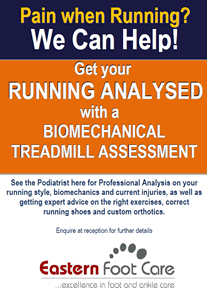Barefoot Running – Dr Renee Forristal discusses its implications
 Barefoot running, or use of ‘minimalist shoes’ has been in vogue of late with running blogs dedicating much debate to this contentious topic. Advocates of barefoot running argue that it promotes stronger lower limbs, improves proprioception, reduces impact forces and lowers rate of injury. Running barefoot or in a minimalist shoe encourages a mid to forefoot strike. With this distal deviation greater knee flexion is achieved and the ground reaction force upon impact is reduced. Cushioned shoes on the other hand promote a heel strike. It is proposed that this can act as a ‘brake’, slowing the runner down. Also implied is amplification of impact forces due to greater extension at the knee.
Barefoot running, or use of ‘minimalist shoes’ has been in vogue of late with running blogs dedicating much debate to this contentious topic. Advocates of barefoot running argue that it promotes stronger lower limbs, improves proprioception, reduces impact forces and lowers rate of injury. Running barefoot or in a minimalist shoe encourages a mid to forefoot strike. With this distal deviation greater knee flexion is achieved and the ground reaction force upon impact is reduced. Cushioned shoes on the other hand promote a heel strike. It is proposed that this can act as a ‘brake’, slowing the runner down. Also implied is amplification of impact forces due to greater extension at the knee.
A review of the literature demonstrates a vast selection of studies that compare heel strike to a mid/forefoot strike. Whilst it does appear impact forces are reduced the research appears unable to conclude how clinically significant this is.
I feel that the question as to whether barefoot running can be considered superior lies with whether it can be proven as a less injury prone and faster form of running. The biomechanics of barefoot running may prove advantageous for some musculoskeletal structures however for others these movements are liable to incite injury. Enhanced plantarflexion will intensify load on the Achilles tendon, plantar fascia and structures within the forefoot. Examination of elite endurance runners found that many are heel strikers. Consideration of this may demote the claim that a change to a mid/forefoot strike can be used to improve running speed. Overall it appears science is yet to catch up with the beliefs of barefoot running advocates.
A comprehensive biomechanical assessment is highly recommended for those looking to transition from a heel strike to a forefoot strike. Any anomalies detected may be addressed prior to implementation of the gait changes. An appropriate training plan can be generated and your podiatrist will be able to guide you through this. Close monitoring for injuries is also important. In addition appropriate strengthening and stretching exercises will be provided to enable musculoskeletal structures to cope with the change in load.